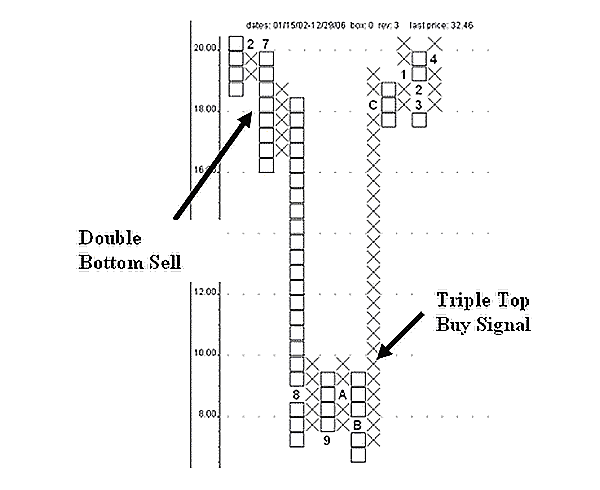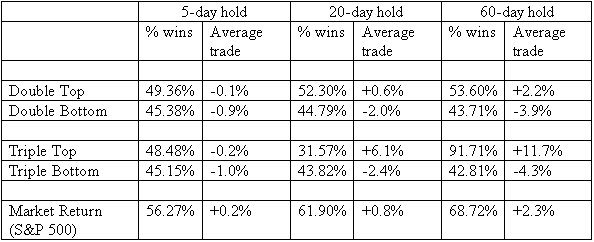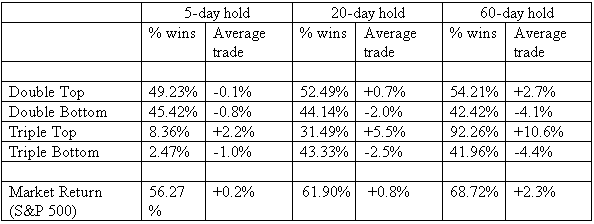
HOT TOPICS LIST
- Strategies
- Stocks
- Buy
- Investing
- Brokers
- Psychology
- Interviews
- Accumulate
- Sell
- Hold
- Spotlight
- Websites
- Candlestick Corner
- Gold & Metals
- Options Trading
LIST OF TOPICS
THE CHARTIST
Testing Point & Figure Patterns
05/29/08 02:53:36 PM PSTby Michael Carr, CMT
Considered to be a superior charting technique by some technical analysts, objective testing reveals the truth about simple point & figure chart patterns.
| Point & figure (P&F) charts have been used by market technicians for more than a century. These charts were used by Charles Henry Dow in the late 1800s, and the first detailed explanation of this technique was published by Victor deVilliers in 1933. DeVilliers' book, The Point & Figure Method Of Anticipating Stock Price Movements, preceded the classical text for interpreting the more popular bar chart, Robert Edwards and John Magee's Technical Analysis Of Stock Trends, by 15 years. P&F charts track only changes in price and ignore the passing of time. Proponents of this technique believe that by focusing solely on significant price changes, they eliminate the distraction of day-to-day market noise. With a chart free of the smaller movements that make up most of a stock's trading activity, it should be easier to identify significant support and resistance levels. Some of the common patterns identified in P&F charts provide precise trade entry and exit points. Until now, however, test results have not been widely available showing whether these simple patterns work. This article analyzes actual results of the simplest P&F patterns, seeing how they perform in real life, because traders and investors need data, not tradition and folklore, to be successful in today's markets. TESTING A TRADITIONAL TOOL
|
| To determine if the signals are effective trading tools, we will test the success of these four patterns using all the stocks that make up the Standard & Poor's 500, using data from January 1, 1990 (or when the stock started trading), through December 31, 2006. As an initial test, we closed each trade when the stock moved 5% from the entry price. In other words, a winning long trade is one in which the price increased by 5% before it decreased by that amount after an entry signal. A losing long trade is one where the price declined by 5% before rising by 5% after a signal. For short trades, winners declined by 5% before rising by 5% and losers rose by 5% from the entry price before declining by at least that amount. All tests resulted in at least 10,000 trades, which is enough of a sample size to give us confidence in the results. These results are summarized in Figure 2 and show that these P&F patterns have no predictive value, offering only a 50/50 chance of being right on any given signal. After trading costs are considered, systems based solely upon these signals would have led to significant losses.
|
| A technical tool like the P&F chart that has been employed by traders in stock and commodity markets for more than a hundred years deserves a more thorough evaluation. For the next series of tests, we looked at entering the trade at the opening the day after the signal. Trades were exited after several holding periods. A five-day period was chosen to determine if the P&F signal usually resulted in an immediate follow-through in the direction of the breakout. Twenty days is a typical trading month and should reflect the performance of the signal over the intermediate term, and a 60-day holding period is examined to measure the long-term significance of these signals. For comparison with a market return available to passive investors, the price change of the S&P 500 over the same holding periods is included in the test results summarized in Figure 3.
|
| Again, each signal resulted in at least 10,000 trades, except for the S&P 500, which had more than 4,000 trades representing five-day holding periods. Given this sample size, we can be reasonably confident in the statistical reliability of the results. From Figure 3, we can conclude that in the short term, relying solely on simple P&F signals does not help traders gain an edge in the stock market. Over longer time frames, only the triple-top buy signal generated market-beating returns. While the test period for this analysis, 1990 through 2006, included the brutal 2000-02 bear market and a 50% drop in the S&P 500 along with several shorter minibears, it was generally a period of rising prices. That may have led to a bullish bias in our tests that could partially explain the poor performance of sell signals. The last question to consider is whether signals should be filtered by the longer-term trend. Since the trend is your friend, it makes sense to take buy signals in a stock only when the stock is trending higher and to take sell signals only in confirmed downtrends. We chose to use a 13-week simple moving average to identify the trend. If prices are above their 13-week average, then long trade signals are taken and short trade signals are ignored. Similarly, short trades are only entered when the price is below its 13-week moving average. Long signals occurring with prices below the moving average were ignored. The results of the P&F signals, filtered with the 13-week simple moving average to confirm the trend, are shown in Figure 4.
|
| Surprisingly, we found that adding a trend filter did not result in any significant performance improvement. The triple top is still the best signal, and the relative order of merit of the other signals is unchanged. TRADER BEWARE In testing, only the triple-top buy signal outperforms the stock market across all time frames. Traders can use this strategy and obtain a very high number of winning trades. Perhaps the best use for P&F charts, however, is for traders to employ them as one component of a trading strategy, for example assessing the overall trend from the most recent signal, and accepting trades based upon another indicator, such as the relative strength index or stochastics. SUGGESTED READING Dorsey, Thomas [2001]. Point And Figure Charting, John Wiley & Sons. Edwards, Robert D., and John Magee [2007]. Technical Analysis Of Stock Trends, 9th ed., W.H.C. Bassetti, ed. AMACOM. |
Mike Carr is a member of the Market Technicians Association and editor of the MTA's newsletter, Technically Speaking. He is a full-time trader and writer.
| E-mail address: | mcarr@dunnwarren.com |
PRINT THIS ARTICLE

|

Request Information From Our Sponsors
- StockCharts.com, Inc.
- Candle Patterns
- Candlestick Charting Explained
- Intermarket Technical Analysis
- John Murphy on Chart Analysis
- John Murphy's Chart Pattern Recognition
- John Murphy's Market Message
- MurphyExplainsMarketAnalysis-Intermarket Analysis
- MurphyExplainsMarketAnalysis-Visual Analysis
- StockCharts.com
- Technical Analysis of the Financial Markets
- The Visual Investor
- VectorVest, Inc.
- Executive Premier Workshop
- One-Day Options Course
- OptionsPro
- Retirement Income Workshop
- Sure-Fire Trading Systems (VectorVest, Inc.)
- Trading as a Business Workshop
- VectorVest 7 EOD
- VectorVest 7 RealTime/IntraDay
- VectorVest AutoTester
- VectorVest Educational Services
- VectorVest OnLine
- VectorVest Options Analyzer
- VectorVest ProGraphics v6.0
- VectorVest ProTrader 7
- VectorVest RealTime Derby Tool
- VectorVest Simulator
- VectorVest Variator
- VectorVest Watchdog




